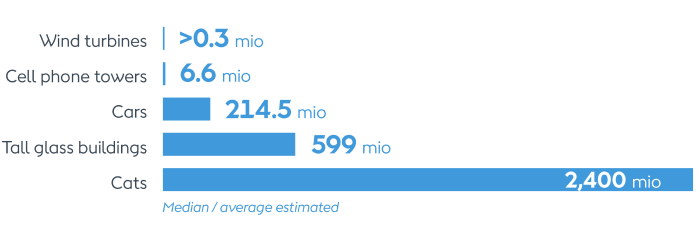Do wind turbines pose a massive threat to birdlife?
Only a tiny proportion of bird deaths are due to wind turbines. Climate change poses a much greater threat, and wind power is helping fight this.
Recently, wind turbines have received a lot of attention as a cause of death for birds. While it is true that some birds die every year by flying into turbine towers or blades, the actual numbers are negligible.
A study in the UK observed only six bird deaths in an offshore wind farm over two years.1
Meanwhile, in the United States, statistics show that wind energy facilities cause less than one in 4,000 documented bird deaths from industrial activities.2

Meanwhile, entire species and ecosystems are threatened by the unprecedented changes to Earth’s atmosphere that we’re already seeing as a consequence of burning fossil fuels. For example, almost 400 North American bird species are thought to be at risk of extinction as a result of climate change.2
The transition from fossil fuels to clean energy is one of the biggest steps we can take to limit these changes and protect all plant and animal life on Earth.
The numbers may already be small, but at Ørsted we care about making sure our activities as a wind power developer pose as small a threat to birds as possible.
Before we construct any of our projects, we undertake an environmental impact assessment. Among other things, this investigates the possible effect our project might have on biodiversity, including all birdlife. We submit this assessment to the relevant planning authorities and, where feasible, take action to mitigate predicted impacts as much as possible.
We also continue monitoring impacts throughout the operational life of the wind farm. On existing projects, this has included carrying out tagging studies to understand the movement of birds in and around turbine structures.
Meanwhile, our research and development programme supports the latest innovations to help reduce the impact of wind farms on birds. In the US, we work with the American Wind Wildlife Institute and invest in new technology to assess projects, improve conservation, and implement the latest solutions to protect birds on our wind farms.